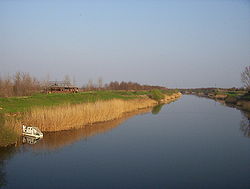
Back Pannoniese Laagvlakte Afrikaans حوض بانونيا Arabic حوض بانونيا ARZ Llanura panónica AST Ortadunay düzənliyi Azerbaijani Урта Дунай уйһыулығы Bashkir Сярэднедунайская нізіна Byelorussian Сярэднедунайская нізіна BE-X-OLD Среднодунавска низина Bulgarian Panonska nizija BS
This article needs additional citations for verification. (August 2024) |




The Pannonian Basin, with the term Carpathian Basin being sometimes preferred in Hungarian literature,[1][2][3] is a large sedimentary basin situated in southeastern Central Europe. After the Treaty of Trianon following World War I, the geomorphological term Pannonian Plain was also used[citation needed] for roughly the same region, referring to the lowlands in the area occupied by the Pannonian Sea during the Pliocene Epoch, the term "Pannonian Plain" being considered not only unhistorical but also topologically erroneous.[citation needed]
- ^ Balogh, Péter (January 2021). "The concept of the Carpathian Basin: its evolution, counternarratives, and geopolitical implications". Journal of Historical Geography. 71: 51–62. doi:10.1016/j.jhg.2020.12.003. Retrieved 4 May 2025 – via sciencedirect.com.
- ^ Adami Jordan; Peter Jordan; Milan Orožen Adamič (2007). Exonyms and the International Standardisation of Geographical Names: Approaches Towards the Resolution of an Apparent Contradiction. LIT Verlag Berlin-Hamburg-Münster. p. 240. ISBN 978-3-8258-0035-2.
- ^ George Walter Hoffman; Christopher Shane Davies (1983). A Geography of Europe: Problems and Prospects. Wiley. p. 647. ISBN 978-0-471-89708-8.